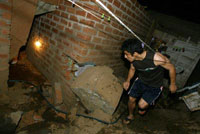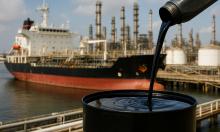Peru’s capital shakes for one minute, about 50 feared dead in quake
A strong earthquake measuring 7.9 on Richter scale hit Peru's coast near the country’s capital on Wednesday. Many buildings were damaged as a result of the quake. At least 15 people were killed when a church collapsed in a southern city.

Click here to see photos of the earthquake in Peru
A tsunami warning was issued for Latin America's Pacific coast, although it was later canceled when the wave measured only 8 to 12 inches (20 to 30 centimeters).
The information on the death toll varies. Peru’s Health Minister Carlos Vallejos said there were 15 confirmed deaths in southern Peru, while Civil Defense officials put the toll at 22. Channel 4 television reported 48 people were killed and more than 300 injured, but did not give a source.
Peru’s President Alan Garcia said that the earthquake had apparently not caused a national catastrophe.
"Thank you, God Almighty, these terrible quakes did not cause a high death toll like in other years," he said in a nationally televised address. He did not say how many had died.
Firefighters said lampposts collapsed and windows shattered in Lima, the capital of Peru. Hundreds of workers were evacuated from office buildings and remained outside.
"This is the strongest earthquake I've ever felt," said Maria Pilar Mena, a 47-year-old sandwich vendor in Lima. "When the quake struck, I thought it would never end."
Cable station Canal N reported that 17 people were killed and 70 injured in the city of Ica, 165 miles (265 kilometers) southeast of Lima. The report said a church had collapsed but it was not clear if the quake was responsible for all the deaths and injuries.
The president ordered all police to the streets of Lima to keep order. He said he was sending three Cabinet members, including the health minister, to the coastal towns of Chincha and Ica, where news reports said the quake hit hardest.
He said public schools will be closed Thursday because the buildings may be unsafe.
Spokespeople for the U.S. Geological Survey said the earthquake hit about 90 miles (145 kilometers) southeast of Lima at a depth of about 25 miles (41 kilometers). The USGS reported six strong aftershocks ranging from magnitudes of 5.0 to 5.9.
The quake struck at 6:40 p.m. local time (2340 GMT).
An Associated Press photographer said homes had collapsed in the center of Lima and that many people had fled into the streets for safety. He said the capital shook for more than a minute.
Callers to Radioprogramas, Peru's main news radio station, said parts of several southern cities experienced blackouts and homes collapsed in poor neighborhoods in the cities of Chincha and Cerro Azul.
The quake also knocked out telephone and mobile phone service in the capital. Firefighters were called to put out a fire in a shopping center. State doctors called off a national strike that began on Wednesday to handle the emergency.
Police reported that large boulders shook loose from hills and were blocking the country's Central Highway east of Lima.
The Hawaii-based Pacific Tsunami Warning Center issued a tsunami warning for the coasts of Peru, Chile, Ecuador, Colombia, Costa Rica and Panama. A tsunami watch was issued for the rest of Central America and Mexico, along with an advisory for Hawaii.
The center canceled all the alerts about two hours later, but said the quake had caused the small tsunami near the epicenter.
"It wasn't big enough to be destructive," said Stuart Weinstein, the center's assistant director.
Officials had previously ordered evacuations of some coastal areas including in the southern Colombian city of Tumaco and the Peruvian port of Callao.
The last time a quake of magnitude 7.0 or larger struck Peru's central coast was in 1974, when a magnitude 7.6 hit in October followed by a 7.2 a month later.
Wednesday's temblor occurred in a subduction zone where one section of the Earth's crust dives under another, said USGS geophysicist Dale Grant at the National Earthquake Information Center in Golden, Colorado.
Some of the world's biggest quakes strike in subduction zones including the catastrophic Indian Ocean temblor in 2004 that generated deadly tsunami waves.
Subscribe to Pravda.Ru Telegram channel, Facebook, RSS!





